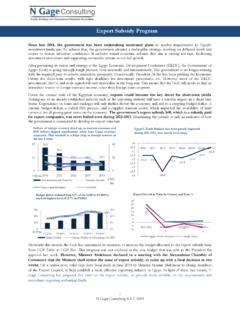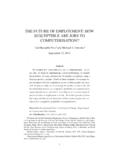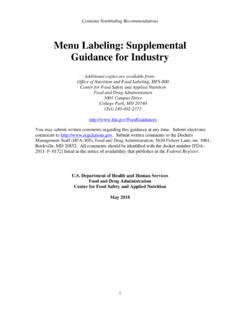Transcription of INNOVATION AND R ELECTRIFICATION IN KENYA (IREK)
1 INNOVATION AND RENEWABLE. ELECTRIFICATION IN KENYA (IREK). A desk assessment on the overviews of current solar and wind energy projects in KENYA Note: The review is largely from unpublished and non-technical sources, such as news articles and project report, retrieved online. The major objective of the review is to get a feel of what is happening around solar and wind energy in KENYA . Contents 1. Overviews on current status quo of solar energy projects in KENYA .. 3. The Kenyan solar energy sector overviews, key facts and 3. Overviews on current solar projects .. 6. Pico-Solar-Home-Systems (1-10 Wp) .. 7. Solar home systems (SHS) (10-100 Wp).
2 14. Stand-alone institutional PV systems (50-500 Wp) .. 17. Mini-grids ( hybrid PV-diesel or Wind) (5 kW-1 MWp) .. 17. Large-scale, grid-connected PV systems (1-50 MWp) .. 27. Overview on the enabling environment of solar energy in KENYA .. 33. 2. Overviews on current status quo of wind energy projects in KENYA .. 35. The Kenyan wind energy sector overviews, key facts and figures .. 36. Overviews on current wind projects .. 37. Overview of current enabling environment of wind energy in 44. 3. Summary of overall observations .. 45. 1. Overviews on current status quo of solar energy projects in KENYA The Kenyan solar energy sector overviews, key facts and figures KENYA has abundant solar energy resources.
3 Its daily average solar insolation is estimated to beabout 4-6 kilowatt hours per squaremeter, which isconsidered one of the best for solar electric energy production in sub-Saharan Africa1. Depending on the conversion efficiency of solar modules, 10-14% of this energy can be converted to electric power2. However, there are regional and seasonal differences in the solar resources of the country. Seasonally, for instance, Nairobi experiences high level of solar isolation from December to February while sun radiation decreases between June and September3. Utilising solar resources in KENYA started in the 1870s, following government's use of solar photovoltaic (PV) systems to operate broadcast installations (masts) in remote areas4,5.
4 In the 1980s, international donors and NGOs began to play a key role in the development of solar energy sector in KENYA to provide electric power to social services, such as school lighting, water pumping and vaccine refrigeration6. However, donor support had gradually phased-out over the years; and since the 1990s the sector has been driven by the private sector. In the early years of PV development in KENYA , solar systems were relatively larger, complicated and expensive. Most of them failed because of lack of capability for appropriate installations and maintenance7. Despite this significant success was achieved in the commercial diffusion of battery-based solar home systems, driven by a desire for TV.
5 Viewingof the rural community8. 1. 2. 3. url=http%3A%2F% MeteringReport% 9 DmkUIwZeuP7Cg&sig2=WlQsT_EDTHfOeMA3w3gE4 w 4. file:///C:/Users/ATigabu/Downloads/Worki ng%20paper%20 Solar%20PV%20 East%20 Africa%20(1).pdf 5. files/staff/ 6. 7. 8. files/staff/ Today a vibrant private sector exists, particularly in the small-scale PV market9. It is estimated that over 320,000 rural households ( of rural people in KENYA ) have solar home systems as of 201010. Annually, it is estimated that 25,000-30,000 PV systems are sold in the market11, 12,13. This means that as of 2015, assuming that each household has at least only one PV system, over 445, 000 to 470,000 PV systems have been installed in KENYA .
6 Other reports put this figure even higher, considering the introduction of low-cost solar lanterns recently. Statistics indicate that solar PV lantern sales have reached to about 1,000,000 units in 201414. The total installed solar power capacity is estimated at 16 MWp as of 2012 in which the vast majority is contributed by solar home systems installed at individual homes15. figures from the Energy Regularity commission (ERC) of KENYA show that the total installed capacity is likely to be over 20 MWp as of January 2015. This is projected to grow at 15% annually16. PV systems commercially distributed to rural areas of KENYA typically consist of 14 to 20Wp, wiring, rechargeable battery, sometimes a charge controller system, lighting systems, and connections to small appliances (such as a radio, television, or mobile phone charging units)17.
7 The spectacular market growth of solar home systems in KENYA is due to strong marketing efforts of the private sector with little (and often times no) support from the government18. However, since 2005, the Government has shown increasing interest for solar energy by providing boarding schools and health facilities in remote areas access to electricity through PV panels. From 3000 institutions in remote areas, about 450 have been equipped with solar PV systems, 220 schools are electrified with stand-alone solar PV with a total capacity of KWp at an estimated cost of million Euros. Additional 10 million euros have 9. file:///C:/Users/ATigabu/Downloads/Worki ng%20paper%20 Solar%20PV%20 East%20 Africa%20(1).
8 Pdf 10. _Evidence_on_solar_home_systems_and_ligh ting_fuel_choice_in_Kenya?ev=prf_pub 11. energie/ 12. file:///C:/Users/ATigabu/ 13. 14. 15. 16. 17. _Evidence_on_solar_home_systems_and_ligh ting_fuel_choice_in_Kenya?ev=prf_pub 18. file:///E:/solar_kenya_gray_litrature/AT PS_Research_Paper_No_28_Urama_Ozor_Kirum ba_Review_of_Keny also been granted by Spain for ELECTRIFICATION of selected public institutions through solar There is also a plan to provide solar electricity for another 400 institutions20,21. Despite this growth, KENYA Renewable Energy association (KEREA) laments that market spoilage due to poor quality of products as well as design, installation and maintenance services has significantly hindered market growth.
9 According to the 2009 census, of the million households not connected to the grid, only (142,000 households) have a solar PV system; this in a country where the solar PV market started in the mid 80's 22. Indeed, a field inspection and testing study' by KEREA (2009) has shown that out of 76 randomly selected PV systems installed by technicians, 64% were found to have some technical installation problems, clearly showing that the technical capacity of some of the technicians is low23. In response to this, KEREA has recently started a voluntary accreditation framework for solar PV businesses in KENYA to increase stove installation quality and consumer confidence on solar businesses24.
10 The University of Nairobi has a product quality testing laboratory for off-grid lighting Two universities train PV technicians, and as a result about 300 technicians enter into the Solar PV sector every year26. There are over 40 solar PV distributing private companies. These include big companies, such as Solarnet, BP Solar, Chloride Exide, Sollatek Electronics, Solagen and Electric Link. Most of these companies are located in Nairobi. Most solar accessories are imported mainly from China, the United Kingdom and the US. The exception is storage batteries, which are locally manufactured27. In 2009, there were three lead acid battery manufacturers, including eight private companies that manufacture solar lamps28.




